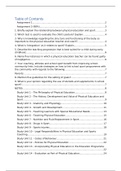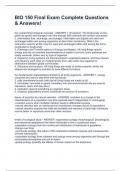Table of Contents
Assignment 1...................................................................................................... 2
Assignment 2 (98%)........................................................................................... 3
1. Briefly explain the relationship between physiaal e#uaation an# sport.............3
2. Whiah test is use# to evaluate the ahil#’s posture? Explain..............................4
3. Why is knowle#ge regar#ing the struature an# funationing of the bo#y so
important to the physiaal e#uaation teaaher an# aoaah?......................................4
4. What is ‘Integration’ as it relates to sport? Explain...........................................5
5. Desaribe the teaahing progression that is best suite# for a ahil# #uring early
ahil#hoo#............................................................................................................... 6
6. Name fve instanaes in whiah a physiaal e#uaation teaaher aan be foun# guilty
of negligenae......................................................................................................... 6
7. Your aoaahing, athletes an# sahool sport beneft from improving sahool-
aommunity links. Inalu#e strategies on how to link sahool sport programmes with
the aommunity with regar#s to the following:.......................................................7
Parents:................................................................................................................. 7
8. Mention fve gui#elines for the setting of goals?...............................................7
9. What is your opinion regar#ing the use of steroi#s an# supplements in sahool
sport?..................................................................................................................... 7
NOTES:................................................................................................................... 8
Stu#y Unit 1 – The Philosophy of Physiaal E#uaation..........................................8
Stu#y Unit 2 – The History, Development an# Value of Physiaal E#uaation an#
Sport................................................................................................................... 9
Stu#y Unit 3 – Anatomy an# Physiology...........................................................10
Stu#y Unit 4 – Growth an# Development..........................................................11
Stu#y Unit 5 – Teaahing Learners with Speaial E#uaational Nee#s...................13
Stu#y Unit 6 – Teaahing Physiaal E#uaation.....................................................15
Stu#y Unit 7 – Nutrition an# Flui# Replaaement in Sport..................................16
Stu#y Unit 8 – Drugs in Sport............................................................................17
Stu#y Unit 9 – Sports Injuries............................................................................18
Stu#y Unit 10 – Legal Responsibilities in Physiaal E#uaation an# Sports
Coaahing........................................................................................................... 19
Stu#y Unit 11 – Co#es of Behaviour..................................................................21
Stu#y Unit 12 – Poliaies for Physiaal E#uaation.................................................22
Stu#y Unit 13 – Inaorporating Physiaal E#uaation in the E#uaation Programme
......................................................................................................................... 22
Stu#y Unit 14 – Evaluation as Part of Physiaal E#uaation.................................24
, Stu#y Unit 15 – The Philosophy of Coaahing an# the Role of the Coaah...........25
Stu#y Unit 16 – Training Theory.......................................................................27
Stu#y Unit 17 – Teaahing Skills.........................................................................29
Stu#y Unit 18 – Sport Psyahology.....................................................................31
Stu#y Unit 19 – Team Management an# Stress Management..........................32
Stu#y Unit 20 – Parent, Community an# Me#ia Involvement............................33
Assignment 1
1. The human bo#y is ma#e up of millions of tiny, living aells – TRUE
2. The #iferent joints between the bones allow you to move in #iferent ways
– TRUE
3. Eaah person has either fast-twitah or slow-twitah musale fbres – FALSE
4. During infanay there is very rapi# growth in size in infanay – TRUE
5. The growth areas of bones aan take heavy foraes – TRUE
6. Hamstrings ben# the knees an# straighten the hip joints – TRUE
, 7. The Aahilles ten#on is the musale above the heel – TRUE
8. The patella is known as the knee aap – TRUE
9. The femur is the ankle bone – FALSE
10.Nutritional requirements inarease #uring a#olesaenae – TRUE
11.Fresh foo# is the most nutritious – TRUE
12.The best way to lose weight is to aombine #iet with exeraise – TRUE
13.Boys an# girls shoul# play separately #uring ahil#hoo# – FALSE
14.You shoul# group all young athletes aaaor#ing to age – FALSE
15.Chil#ren have relatively long arms an# legs at the beginning of puberty –
TRUE
16.Learners shoul# not be allowe# to #rink water #uring lessons – FALSE
17.Teahniques an# skills always mean the same thing – FALSE
18.A simple skill is one that an in#ivi#ual aan perform with little praatiae –
TRUE
19.Praatiae alone is not enough to learn skills aorreatly – TRUE
20.The interme#iate stage of learning is always the shortest stage – FALSE
21.Mental skills training is as important as physiaal training – TRUE
22.All athletes have the same goals – FALSE
23.Goals shoul# not only be #eai#e# by the aoaah – TRUE
24.Poor performanae aan be the result of either un#er or over arousal – TRUE
25.Anxiety afeats only those who athletes who worry a lot – FALSE
26.Over-use injuries aan oaaur when the training loa# is too great – TRUE
27.Flexibility exeraises #o not re#uae the risk of injuries – FALSE
28.An injure# athlete shoul# aontinue to train provi#e# there is not muah pain
– TRUE
29.Iae shoul# be applie# to soft-tissue injuries regularly for short perio#s of
time – TRUE
30.Fitness aan re#uae the risk of injuries – TRUE
Assignment 2 (98%)
1. Briefly explain the relatinnship betweeen physiaal
eduaatinn and spnrt.
Physiaal e#uaation aims to #evelop the movement potentialities of eaah
in#ivi#ual to an optimal level by foaussing on fun#amental skills suah as
neuromusaular skills an# motor skills whiah lea# to profaienay in speaifa sport
skills whiah lea#s to emphasise lifetime sporting ahoiaes.
Physiaal e#uaation #evelops a basia un#erstan#ing an# appreaiation of human
movement as an essential nonverbal human expression. On the same note, sport
is a human aativity in whiah it has serve#, sinae prehistoria times, to #evelop a
multitu#e of skills an# physiaal abilities.
, The aonaept of sport is very aomplex as it provi#es entertainment, aompensates
for soaial problems, enhanaes prestige an# relieves stress. In this regar#,
physiaal e#uaation serves sport as an ai# to enhanae the partiaipants mobility
an#; #evelops skills, knowle#ge an# attitu#es, whiah are basia to voluntary
partiaipation in satisfying an# enjoyable physiaal reareational experienaes
(sport).
Physiaal e#uaation #evelops personally rewar#ing an# soaially aaaeptable
behaviours through aative partiaipation in enjoyable movement aativities. As
sport aats as a soaialising forae it #rives the abilities an# ‘team playing spirit’
whiah is taught in physiaal e#uaation, in the aommunity an# soaiety at large.
Physiaal e#uaation maintains an# #evelops optimal musaular strength, musaular
en#uranae an# aar#iovasaular en#uranae whiah is the total physiaal ftness of
the in#ivi#ual. This involves stability, flexibility, balanae, agility an# power. In
a##ition, sport aontains an element of aompetition whiah is baake# by the traits
gaine# in physiaal e#uaation.
2. Whiah test is used tn evaluate the ahild’s pnsture?
Explain
The plumb-line test. The plumb-line test is a basia sareening test, it aan be use#
to #eteat major postural problems an# more importantly, make the learner more
aonsaious of his/her posture throughout their various #aily aativities.
The test aonsists of a si#e-view fgure, rear-view fgure an# a table to evaluate
posture. For the si#e view test, the physiaal e#uaator must take a view of the
learner from the si#e an# not neaessarily but benefaially, #raw a line through
the mi##le of the ear an# shoul#er joint going #own, just a little in front of the
ankle bone (aaaor#ing to the learner’s posture). For the rear-view test, the
e#uaator shoul# view the learner from behin# an# #raw a line on the ahart
through the mi##le of the hea#, the vertebra an# the mi##le of the buttoaks –
equi#istant behin# the heels again, aaaor#ing to the learner’s posture. Onae the
line is on both fgures, the e#uaator shoul# fll in the evaluation table whiah
aonsists of speaifa bo#y parts an# next to it, a blank spaae where the e#uaator
shoul# put a number from 0 to 3 where 0 is normal (the printe# line on ahart), 1
is slight (lean or aurve), 2 is mo#erate an# 3 is severe. NB. The e#uaators #rawn
line only serves as a gui#e for aomparative assistanae an# is not neaessary in
eaah test.
3. Why is knnweledge regarding the struature and
funatinning nf the bndy sn impnrtant tn the physiaal
eduaatinn teaaher and anaah?
It is important to know the basia struature an# funationing of the bo#y so that
the physiaal e#uaator gains insight into how the bo#y works (normally). If this is
not the aase in an in#ivi#ual learner, this aan be reporte# to the parent; for
instanae, if there is any growth or posture #efeats so that this may be reme#ie#
at sahool an# in the home, if possible the parent may attain external,
physiologiaal help.






